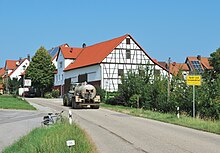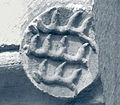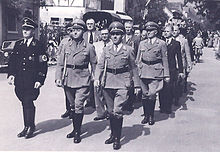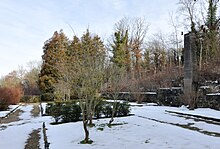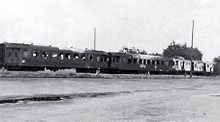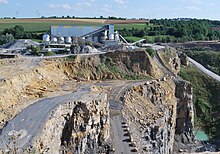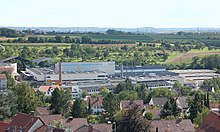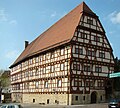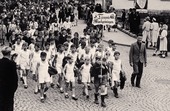Markgröningen
| coat of arms | Germany map | |
|---|---|---|

|
Coordinates: 48 ° 54 ' N , 9 ° 5' E |
|
| Basic data | ||
| State : | Baden-Württemberg | |
| Administrative region : | Stuttgart | |
| County : | Ludwigsburg | |
| Height : | 281 m above sea level NHN | |
| Area : | 28.16 km 2 | |
| Residents: | 14,785 (Dec. 31, 2018) | |
| Population density : | 525 inhabitants per km 2 | |
| Postal code : | 71706 | |
| Primaries : | 07145, 07147 | |
| License plate : | LB, VAI | |
| Community key : | 08 1 18 050 | |
| LOCODE : | DE MKG | |
City administration address : |
Marktplatz 1 71706 Markgröningen |
|
| Website : | ||
| Mayor : | Rudolf Kürner | |
| Location of the town of Markgröningen in the Ludwigsburg district | ||
Markgröningen is a city in the Baden-Württemberg district of Ludwigsburg and part of the German Half-timbered Road . It belongs to the Stuttgart region (until 1992 the Middle Neckar region ) and the European metropolitan region of Stuttgart .
The former imperial , residence and official city of Grüningen became known nationwide for its traditional folk festival, the “ Shepherd's Run ” that takes place every August , and its impressive town hall . The city , which is linked to the imperial storm flag, became the focus of the state's history in the 13th century, when the king and count fought over it.
geography
Geographical location
Markgröningen is located in the Strohgäu and on the edge of the fertile loess plain of the Lange Feld , nine kilometers west of Ludwigsburg and almost 20 kilometers northwest of Stuttgart . The core city, the former Grüningen , lies between the valleys of the Glems and Leudelsbach, which are deeply carved into the shell limestone . On the sun-exposed slopes of the valley, steep vineyards alternate with protected sheep pastures. The Unterriexingen district, which was independent until 1972, is located around four kilometers north of Markgröningen on both sides of the Glems, which flows into the Enz here . Before the district and community reform , the former imperial city had the largest landmark in the district with 2087 hectares . Today the Markgröninger marking covers 2816 hectares; 729 hectares of which come from Unterriexingen.
Interpretation of the place name

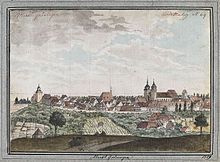
From Gruoninga ...
In 779, Markgröningen was first mentioned as Gruoninga in a deed of donation for the Fulda monastery . Place names with the ending ing (en) were usually created during the migration period and were named after the founder's clan who settled there. In the case of Grüningen, for example, it is assumed that the place name was derived from an Alemannic founder named Gruono . Even today, the former imperial and Württemberg residence town of Grüningen is colloquially called "Gröningen" (pronounced: grenẽŋə ) by the locals .
... to Mark (t) gröningen
The prefix “Mark”, used officially for the first time in the 18th century, is intended to refer to the border location on the Franconian-Alemannic Mark. However, this has not been relevant for a millennium (746). Rather, at the time when the name was added, (Markt-) Gröningen was associated with a characteristic that is well known throughout the country: the nationally significant annual fair for the parish fair of the Bartholomäuskirche , which Hans Grüninger (near Fries ) equated with the important Frankfurt fair in 1527 and which is therefore actually eponymous. Especially since Grüningen is named "Margt Grieningen" in the title of the place description at Fries and Matthäus Merian also lists "Marckt Gröningen" as an alternative name.
The t , which is often swallowed in the Swabian dialect for “Markplatz”, could explain why it was lost in the mark prefix of the place name and thus steered the name interpreters on the wrong track.


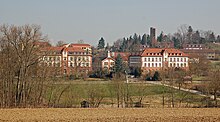

Neighboring communities
The following communities border the city of Markgröningen. They are named clockwise starting in the north and all belong to the Ludwigsburg district :
Sachsenheim , Bissingen ( Bietigheim-Bissingen ), Tamm , Asperg , Möglingen , Schwieberdingen , Hochdorf ( Eberdingen ), Enzweihingen ( Vaihingen an der Enz ) and Oberriexingen .
City structure
Markgröningen is divided into four districts. In addition to Markgröningen itself, these are:
- Unterriexingen
- Talhausen
- Hardt- and Schönbühlhof (only the Schönbühlhof district belongs to Markgröningen, the Hardthof is located in Schwieberdinger district)
More settlements
The Markgröningen branding also includes:
- the large building complex on the Hurst , a ridge west of the Asperg between Andelbach and Riedbach , on which the Werner School, the orthopedic clinic with rehabilitation center, the home for the disabled with staff apartment blocks and a small church as well as an agricultural property and a water tower are located are located,
- the former domain Aichholzhof and to the west of it a substation ,
- the Aussiedlerhöfe Tammer See , Grasiger Weg , Hohe Anwande , Münchinger Weg , Schwieberdinger Weg , Eichholzer Klinge and Lettenbödle ,
- the Rotenacker , Ölmühle , Obere Mühle (quarry) and Raisershaus near the former Konstatt , Bruckmühle and Unteres Schafhaus , Spitalmühle , Untere Mühle , paper mill and hammer mill as well
- the two group sewage treatment plants in Glems - and in Leudelsbachtal .
Desolation around the city
Settlements that have left are (clockwise from northeast to north) Hörnle , Maulbronn , Laiblingen , Konstatt (also Kaunstett ), Schönbühl , Böhringen , Aicholtz , Hinterstatt , Kühlenbronn , Sankt Johännser and the Schlüsselburg on the Markgröninger mark as well as the places Vöhingen on Schwieberdinger , Guckenhäuser in Glemstal, Dauseck Castle and an associated hamlet on Unterriexinger and Remmingen on Untermberger Markung.
Not far from the abandoned Böhringen , the hamlet of Schönbühlhof was founded in 1763 on the western edge of the mark , and shortly afterwards the hamlet of Talhausen in Glemstal, which was abandoned during the Thirty Years' War, was repopulated. Instead of the former hamlet of Aicholtz , the Aichholzhof was built .
Division of space

According to data from the State Statistical Office , as of 2014.
Spatial planning
Markgröningen is part of the Stuttgart metropolitan region as well as the vicinity of the Ludwigsburg / Kornwestheim medium-sized center in the Stuttgart region (VRS).
For the surrounding communities, the former township is only of central importance as a school and clinic location and for wastewater treatment .
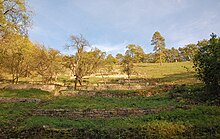
Flora, fauna and geotopes
In particular in the three valleys of Glems , Enz and Leudelsbach there are numerous biotopes worthy of protection , which are largely integrated into the FFH area Strohgäu and the lower Enz valley . The 117.9 hectare nature reserve Leudelsbachtal , which for the most part (98.4 hectares) belongs to Markgröningen and includes the Rotenacker forest , as well as over sixty areal and 13 individual natural monuments (ND) are under special protection . In addition, larger parts of the landscape protection areas Oberes Leudelsbachtal , Hohenasperg-Hurst and the surrounding area , Glemstal between Schwieberdingen and Markgröningen with outlying areas and Enztal between the Leinfelder Hof and Bietigheim-Bissingen are on the Markgröninger mark.
In addition to the nature conservation authorities and the city administration, local groups from BUND , Nabu and SAV take care of nature conservation issues in Markgröningen .
The State Geological Office (LGRB) has recorded eight geotopes on the markings : three groups of sinkholes in Hinterholz, in Muckenschupf and in Rotenacker , a loess profile near the former brickworks, three abandoned quarries in Eichholzer Klinge, in Leudelsbach - and in Glemstal and around a hundred Meter long Siegfried rock on the right slope of the Glems. In addition, there are numerous other outcrops on the markings , in particular along the edge of the slope on Rotenacker and on the steep slopes of Glems Valley, for example on Sonnenberg or at the former ice cellar on Schäferweg.
Climate data
|
Average monthly temperatures and precipitation for Markgröningen
Source: Precipitation: mean values for the period 1961–1990 (ZIP; 338 kB);
Source: Temperature information , hours of sunshine, rainy days: holidaycheck.de: Climate information for Markgröningen (accessed on August 13, 2012) |
|||||||||||||||||||||||||||||||||||||||||||||||||||||||||||||||||||||||||||||||||||||||||||||||||||||||||||||||||||||||||||||||||||||||
history
The history of the town of Grüningen from the High Middle Ages to the historical turning point , which took place through the founding of Ludwigsburg (1718) and the subsequent renaming to Markgröningen , is dealt with in a separate Wikipedia article.
Therefore only a brief overview of the Grüninger period follows . The more recent history of Markgröningen (from 1718) and contemporary history (from 1945), however, will be discussed in more detail and exclusively.
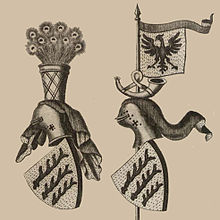

History of Grüningen in fast motion
The previously alemannische Grüningen was about 500-750 a Frankish bulwark at one vertex of the Frankish-alemannischen limit and to the high Middle Ages from the Glemsgau out market Konigsgut : Burg and municipalities have the kings which preferably Swabian carrier of the kingdom storm flag as with this " Burggrafenamt “ Hand over connected fief .
The imperial city and the Württemberg people
The imperial city became the focus of history in the 13th century when its Württemberg fiefdom bearer and imperial ensign , Count Hartmann II. Von Grüningen , and his son Hartmann III. von Grüningen , opposed the policy of revocation by King Rudolf von Habsburg . After years of armed conflict, Hartmann III. Captured in 1280 and died on the Asperg. His half-brothers then had to return the city, which had been chosen as a ducal residence and expanded accordingly, to the king.
In 1336, the imperial storm flag with county, castle and town came into the hands of the Württemberg counts, who seemed obsessed with it and who also featured their possessions as dukes and kings on their coats of arms (see picture bar). As their second residence and official town, Grüningen experienced a second spring at the end of the Middle Ages: The small trading metropolis had the richest citizens of Württemberg and one of the most influential patrician families with the Volland clan . The impressive department store and town hall, the late Gothic choirs of the two churches, the benefice house of the hospital and numerous other buildings keep the memory of this heyday alive just as much as the shepherd's run that takes place every August .
Revolutionary in the pulpit
Where there are winners, there are also losers. And the Tübingen theologian and Grüningen parish priest Dr. Reinhard Gaißer : This “first social revolutionary in a Württemberg pulpit” called on the common man in Grüningen and elsewhere to revolt against Duke Ulrich's unjust tax policy and the early capitalist honesty . In doing so, Gaißer became the intellectual head of the poor Konrad and, as " parishioner " of the Landkapitels Grüningen, an equal opponent of the local bailiff Philipp Volland .
War damage and population losses
In the Thirty Years War (1618–1648) Grüningen was initially not directly affected by the war, but in 1626 it lost 466 inhabitants due to a wave of plague. After the battle of Nördlingen (1634) lost by the Protestants and the escape of Duke Eberhard III. From Württemberg into exile in Strasbourg, the war came to the city: During the siege of Hohenasperg Fortress , the imperial troops reliant on " self-sufficiency " resided relentlessly in the surrounding communities and squeezed the population down to the last shirt. Those who survived torture, rape and pillage were confronted with famine and epidemics. In 1638 there were still 40 citizens in the city, many houses damaged or destroyed.
After the end of the war (1648) the city was able to compensate for this low blow due to immigrants, especially from Switzerland. However, in the course of the French invasions during the Palatinate and Spanish War of Succession , the Grüningen citizens had to accept further destruction, countless looting and damage to the fields by occupation troops. A famine that broke out in 1693 is said to have killed 177 Grüningers. It took the city a hundred years to compensate for the population losses since 1634.
Probably the oldest Wurttemberg coat of arms carved in stone can be found on the basement of the rectory
Coat of arms of the Ludwigsburg district with Grüninger imperial eagle and Württemberger stag above it
Coat of arms of the royal seat and administrative city of Ludwigsburg, founded in 1718, with the imperial storm flag

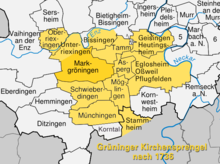



Modern history of Markgröningen
Loss of importance due to the founding of Ludwigsburg
The absolutist Duke Eberhard Ludwig von Württemberg finally initiated an irretrievable and almost existence-threatening loss of importance : with the construction of the Ludwigsburg residential palace (from 1704), for which the Grüninger citizens were heavily involved, and in particular the foundation of the city of Ludwigsburg (1718) in the Grüningen official area that reached as far as the Neckar . In May 1718, the Grüninger Vogt Georg Christoph Andler, the town clerk and a member of the City Court were summoned to Stuttgart and detained there until they agreed to the proposed interventions in the Grüninger statute and office.
With this, the city , which was soon officially called Markgröningen , only lost its function as a ducal second residence and refuge for the imperial storm flag at the castle and, after dogged resistance that lasted into the 19th century, it also lost its functions as the upper bailiwick , upper administrative city , high court , deanery and camera office to the upper office or the City of Ludwigsburg . For this reason, the Ludwigsburg district, as the successor body of the Gröningen Regional Office, now has the Grüninger eagle in its coat of arms, and the district town of Ludwigsburg adorns itself with the imperial storm flag (see illustration).
To the annoyance of the people of Grüningen, Duke Eberhard Ludwig had also divided the Schäferlauf , their identity-creating "oldest folk festival in Württemberg", into four: From 1723 guild meetings and shepherds were also held in Heidenheim , Urach and Wildberg .
In 1724, the first part of the Markgröninger Castle was demolished. The stones had to be carted to Ludwigsburg for reuse. In Rotenacker also a sand quarry had been laid for the construction of the castle and town of Ludwigsburg.
From the 18th century to the seizure of power (1933)
The expansion of Ludwigsburg meant that there was no longer any notable increase in population in Markgröningen and the once brisk construction activity almost came to a standstill. With the reorganization of the young Kingdom of Württemberg in 1807, the city finally lost the function of the previously trimmed Oberamt and was assigned to the Oberamt Ludwigsburg . In Markgröningen, the burden of debt and the impoverishment of the population saw themselves as near doom: 150 families had to be supported by the hospital. That is why all hope was placed in King Friedrich's successor : the “most submissive, most loyal magistrate of the city of Gröningen” put on a petition to the new King Wilhelm on November 20, 1816 , in which he impressively explained the plight of the city and the establishment of a new one Oberamt around the "2700 souls", "the city of Gröningen, which has been connected to the ... regent house since the grayest antiquity". Only the communities in the immediate vicinity were included in the constructive proposal: Asperg, Tamm, Bissingen, Unterriexingen, Hochdorf, Hemmingen, Schwieberdingen and Möglingen. The “most serene” regent, however, did not respond. 1819 was also the 1807 furnished in Markgröningen and 1813 for the office on the Hohenasperg Advanced Kameralamt today in the house closed down Bartholomew pharmacy. Hochdorf, Oberriexingen, Unterriexingen and Pulverdingen were assigned to the Kameralamt Vaihingen an der Enz , Hemmingen to the Kameralamt Leonberg . Markgröningen, Asperg and the other surrounding communities came to Ludwigsburg.
As a result of being downgraded to an official municipality, Markgröningen came more and more into the traffic shadow of Ludwigsburg. In the competition with Bietigheim for the routing of the " Westbahn " railway line from Ludwigsburg to Mühlacker around 1850, despite the more favorable geographical conditions, they lost out. The route through the Leudelsbachtal would not only have been shorter, it would also have enabled a gentle descent into the Enztal suitable for the railway and would not have required an expensive viaduct as in Bietigheim. No wonder that the bypassed Markgröningen saw corruption in the game. Without a rail connection, there was little to attract industry and commerce, saw Bietigheim passing by and remained in stagnation until the First World War , which cost the city exactly 100 inhabitants. During the war, Markgröningen was connected to the power grid in 1915 and still to the rail network in 1916. However, only via a branch line connection from Ludwigsburg via Möglingen to Markgröningen, whose planned connection to Enzweihingen was never to be realized despite the fact that the land was partially acquired. In the times of need after the war, the clammy city first closed the “children's school” and in 1922 even the Latin school , first mentioned in 1354 . In 1923 the post of hospital administrator was finally abolished.
In the 19th century, seemingly desperate attempts to escape its “deep sleep” cost the city considerable parts of its medieval city fortifications and its extraordinary historical building structure, which had retained its late medieval appearance due to stagnation. A look at the above panorama (around 1800) and sketches by Carl Urban Keller suggest that the city has taken away a great tourist potential à la Rothenburg ob der Tauber .
Around 1870 the city recorded a temporary high of around 3400 inhabitants. By 1900 the population sank again by about 300 people, although in 1897 the country had set up a poor institution for the Neckar district on the road to Asperg, popularly known as “Asyl” . Numerous Markgröningers had emigrated to America or Eastern Europe for lack of prospects. The first industrial establishment promised an upswing: Around 1900 the "silk weaving mill Kollmer - Müller" went into operation on Tammer Straße, which had promised at least 70 women jobs at the start. In 1914 there were 3223 and finally 3778 inhabitants in 1939.
Period of National Socialism and World War II
On April 6, 1933 by DC circuit of the Interior Ministry, the municipal council resolved -Dekret and trimmed the local self-government. In the “new election” of ten instead of 16 city councilors on April 27, the result was certain from the start. Six of the future councilors appeared in SA uniforms for the installation. KPD and SPD were no longer represented. In the course of a local council meeting convened by the NSDAP local group leader Wilhelm Schmückle, Mayor Heinrich Zillhardt was deposed on July 20, 1933 with flimsy grounds. Although the former hospital administrator had received 88 percent of the vote before the “seizure of power”, the population did not openly rebel against this coup by the NSDAP. However, three councilors and two successors reacted by resigning from office. Their vacant seats were then not filled again. From then on, only party members sat on the committee. After the local elections were abolished in 1935, even these only had an advisory role and were appointed by the local party leadership if necessary. Bahnhofstrasse was renamed "Adolf-Hitler-Strasse". The Schäferlauf got a "folkish" character. The Friends of Nature House built between 1913 and 1919 over the Leudelsbachtal was removed from the socialist “ Tourist Association Die Naturfreunde ” and converted into a convalescent home for mothers.
During the Second World War , a subcamp of the Natzweiler-Struthof concentration camp was set up in the then still independent community of Unterriexingen , in which from October 1944 to April 1945 around 1000 mostly Jewish prisoners were used for forced labor at the Großsachsenheim air base, building tunnels and cleaning up after air raids. Many of them perished under the most miserable conditions, around 250 of the dead were buried in the concentration camp cemetery on the mountainside above the road to Oberriexingen . An obelisk and a memorial plaque commemorate these victims of the Nazi regime of violence . As part of the “ euthanasia program ” between 1940 and 1941, 120 inmates of the “Landesheim” for the disabled were transported to Grafeneck and murdered.
The city was largely spared from the air war and recorded only a few bomb hits. On March 13, 1945, however, French fighter pilots stopped the departing after-work train by dropping a bomb in front of the locomotive and repeatedly shot at the fully occupied wagons with their on-board cannons. There were 24 dead, including the four-man train crew, and around 50 injured: mainly employees of the Krone and Porsche production facilities relocated to Markgröningen, as well as some Russian prisoners of war. The artillery bombardment of the city by the approaching French ground troops, however, was limited because it was not declared a "fortress" shortly after the Neckar-Enz position and the " Volkssturm " soon vanished into thin air or had been ordered to the east. During war missions or in captivity, Markgröningen had lost a total of 204 “Sons of the City”.
The idiosyncratic handling of the then still numerous farmers with the regulations of the Nazi regime, which was mostly welcomed by the " Reichsnährstand ", was to pay off for the city at the end of the war: Because they had integrated the French prisoners of war assigned to them into family life far more than allowed, they settled in In return for the fact that the French troops moving into Markgröningen on April 21, 1945, treated the population with comparative care. On July 15, 1945, “Americans” replaced the “party-happy” French and prevented looting when they left.
Forced laborers who had not yet returned home from Poland and Russia undertook raids in the vicinity of Markgröningen after the Second World War and also visited Talhausen , the Aichholzhof, the Landhaus Frank and the Spitalmühle . On the night of November 10, 1945, they attacked the hospital mill, drove all residents into the cellar and shot them to the head. The gang were caught and detained by the American military police in 1946. The two alleged gunmen were executed.
Contemporary history from 1945
Since the city had become part of the American zone of occupation after the Second World War , it had belonged to the newly founded state of Württemberg-Baden since 1945 , which was merged into the current state of Baden-Württemberg in 1952.
In the post-war period, the city, which was relatively unaffected by the Allied bombing, had to take in numerous "bombed out" people, refugees and displaced persons. This population increase from 3927 (1943) to 4602 inhabitants (1946) could initially only be managed by billeting. Ultimately, it not only led to the designation of new building areas, but also to a religious mix, since most of the new citizens were of Catholic faith. In 1954, the city gave its young parish the hospital church , the missing main nave of which was replaced by an extension. From 1980 to 1982 the extension was replaced by a new church with a tent roof.
In 1950, the teacher seminar set up in the former castle in 1873 was closed and a girls' boarding school was installed as a “state advanced high school”, which students from Markgröningen living at home were also allowed to attend. In the meantime, the district and town have taken over the “Helene-Lange-Gymnasium” from the state, closed the boarding school and converted it into a school for both sexes with a focus on music.
Since 1963, the main day of the Schäferlauf is no longer fixed on August 24th, but on the Saturday of the last weekend in August. The International Music Festival has been taking place a week earlier since the 1960s.
In the 1960s and early 1970s, the city paid little attention to its historical brand essence: In the course of a wave of modernization that is unthinkable today , numerous valuable buildings in the old town fell victim to the excavator to make room for “concrete boxes” or parking spaces. A rethink only took place in view of the 1200th anniversary of the first documented mention (779), which was celebrated in 1979 with a large festival. Since the eighties, many houses have been renovated in an exemplary manner and, if necessary, awarded the monument prize. The remaining building fabric was enough to be integrated into the Deutsche Fachwerkstrasse .
In 1968 the city began building the education center on Benzberg. After the completion of the Hans-Grüninger-Gymnasium , the secondary school and two sports halls with sports grounds followed. Students in secondary schools no longer had to commute. Instead, many students from Möglingen, Schwieberdingen and Hemmingen went to school in Markgröningen from then on.
Despite the steady population growth, the DB stopped passenger traffic on the Ludwigsburg-Markgröningen branch line in 1975 . Reactivation efforts were unsuccessful. Instead, freight traffic has since been discontinued. The new east bypass pierced the remaining tracks.
As part of the community reform , Unterriexingen was incorporated on January 1, 1973. Markgröningen had 9902 inhabitants and Unterriexingen 1889 inhabitants on the reporting date.
In 1989, Markgröningen entered into its only town twinning with Saint-Martin-de-Crau , which lies in the middle of the Crau between Arles and Marseille .
politics
mayor
After taking over the city, the French occupation forces put the French-speaking doctor Dr. Karl Umbach as interim mayor. In 1946 the young councilor elected Karl Graf as mayor, who remained in office until 1954 after being re-elected by the population. This was followed by Emil Steng until 1974 and Heinrich Vogel, who switched to business in 1990 after two eight-year terms in office. Since then, Rudolf Kürner has been in office, who was re-elected on February 16, 2014.
Municipal council
From 1946 to 1953 the council had twelve and until 1972 sixteen members. With the incorporation of Unterriexingen on January 1, 1973, their number initially increased to 26, because all Unterriexingen councilors were taken over, and then leveled off to 22 plus possible compensatory mandates. Since the 2009 election, the municipal council, which is elected for five years, has 22 members. The local election on May 26, 2019 resulted in the following result: The municipal council consists of the elected voluntary councilors and the mayor as chairman, who is entitled to vote in the council.
| Parties and constituencies |
% 2019 |
Seats 2019 |
% 2014 |
Seats 2014 |
||
| FW | Free voters Markgröningen-Unterriexingen | 37.03 | 8th | 35.0 | 8th | |
| SPD | Social Democratic Party of Germany | 19.59 | 4th | 23.8 | 5 | |
| CDU | Christian Democratic Union of Germany | 22.92 | 5 | 27.2 | 6th | |
| GAL | Green alternative list Markgröningen | 17.52 | 4th | 14.0 | 3 | |
| FDP | Free Democratic Party | 2.94 | 1 | - | - | |
| total | 100.0 | 22nd | 100.0 | 22nd | ||
| voter turnout | 57.57% | 45.9% | ||||
False part choice
In Markgröningen there is the Unechte Teilorteschahl . With it, the Unterriexingers are guaranteed four seats in the municipal council. For the state elections in Baden-Wuerttemberg in 2016 , a referendum took place in Markgröningen polling stations on the question of whether the false sub-district election should be retained or abolished. A clear majority voted against abolition. Of the 11,428 eligible voters, 6,925 took part in the referendum (voter turnout: 60.6%). 4,788 citizens voted against abolition (41.9%), 1921 voted for abolition (16.8%). This achieved the quorum of approval of 20 percent of all eligible voters, which ensures validity .
City coat of arms and imperial storm flag

|
The blazon of the Markgröningen city coat of arms reads: Under a blue shield head, inside five six-pointed golden stars, in gold the red-tongued black imperial eagle. The eagle indicates the status of the formerly free imperial city of Grüningen , which was lost in 1336 when the castle and city were bequeathed to the Württemberg counts with the imperial storm flag. The city coat of arms, which was used without a shield head until the 19th century, has been detectable in the city seals since 1299 and was still used under Württemberg rule. The sometimes green and finally blue shield head with stars was adopted from the former official coat of arms . The city flag has been blue-yellow since the 17th century (see coat of arms from 1591). |

|
The imperial storm flag , lent together with the right of action , the castle and the town of Grüningen , was traditionally kept in the Grüningen imperial castle or, from 1555, in the subsequent residential palace . As square script she showed how the Reichsbanner the black imperial eagle in a golden field and was also a top-mounted, long red Schwenkel provided. After the construction of the Ludwigsburg Palace, the prestigious equestrian flag was brought to Ludwigsburg and has since adorned the Ludwigsburg city arms. The flag is lost. |
Partnerships
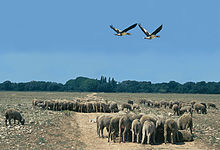

|
The hamlets of Hardthof and Schönbühlhof , which are on the border of the Markgröningen region, are managed by the municipalities of Markgröningen and Schwieberdingen on a partnership basis. The interests of the approximately 330 residents traditionally represent a lawyer chosen by them vis-à-vis the two parent communities , even if this function is no longer provided for in today's community regulations. |

|
Markgröningen has had a town partnership with Saint-Martin-de-Crau in the south of France since 1989 , which was brokered by internationally active conservationists. Like Markgröningen, Saint-Martin-de-Crau was once a Mecca for regional shepherds. The city administration has published a “NatUrlaub” travel guide for visits to the twin city. The town twinning association and the Club de Jumelage coordinate the contacts between the cultural and sports associations of both municipalities. |
Economy and Infrastructure
Agriculture and viticulture
Fewer companies, dismantling of the infrastructure
The marking shows outstanding arable soil and was therefore compared with paradise in the Middle Ages. The intensification of agriculture and several land consolidations have changed the character of the cultural landscape , which is characterized by real division and three -field farming . The number of farms has fallen sharply since the 1950s. In 2010 there were still 38 companies in Markgröningen. 22 of them worked full-time and twelve part-time.
The loading of sugar beet at the train station was stopped in the early 1990s. The Raiffeisen branch of the WLZ near the train station was closed and demolished after the takeover by Baywa . Farmers therefore have to accept further routes to deliver their products or to purchase means of production. Of the many mills, only the Spitalmühle an der Glems was still in operation, which processed grain for grinding with three double roller mills and a stone grinding process. It has been owned by the same family since 1817, which still sells flour but no longer grinds itself.
Viticulture
In the late Middle Ages, viticulture was an important economic factor and Grüninger wine was a lucrative trade good. This can still be seen today from the originally large vineyards, the two large wine presses and the numerous wine cellars in the old town. Since the fifties, however, many difficult-to-work steep slopes have been given up and the wine presses have been shut down. Nobody is doing full-time viticulture anymore. Most of the remaining part-time winemakers cooperate with the Roßwag-Mühlhausen cooperative winery. Some of them still run their taverns .
The Markgröninger vineyards on the slopes of Glems- and Leudelsbachtal, in Sankt Johännser and on the Hurst belong to the large Schalkstein location in the "Württembergisch Unterland" area of the Württemberg wine-growing region .
Business promotion
The city administration has an economic development agency who takes care of the concerns of local businesses and start-ups. In addition, he is responsible for the location marketing and strives to win further companies for the settlement on newly developed commercial areas (around 7 ha) or as successors to discontinued companies and shops. In the old town there are always empty shops. The increasing motorization of the population in the 1970s and the construction of a large shopping center near Ludwigsburg have led to a reduction in what was once the extensive range of retail outlets.
The brick factory damaged by Hurricane Lothar was shut down and will soon make way for a residential area.
Larger local businesses
- Benseler group of companies with several locations for surface technology, coating and deburring, especially for the automotive industry and its suppliers.
- Bosal Oris Fahrzeugteile Hans Riehle GmbH , manufacturer of trailer hitches, wind deflectors and other vehicle accessories with around 550 employees across Germany.
- Kumpf, Fruchtsaft GmbH & Co.KG with headquarters in Unterriexingen, merged with Hassia Mineralquellen GmbH & Co. KG in 2009 .
- Mahle GmbH , piston manufacturer with two local subsidiaries: Mahle Kleinmotoren-Components GmbH & Co. KG and MAHLE Industriemotoren-Components GmbH .
- Trans-Logo-Tech GmbH (TLT) in Unterriexingen, which took over the Markgröningen location of the unwound needle felt manufacturer Magna Näher on June 1, 2014 .
Jobs
In Markgröningen there are over 500 business premises with an average of ten employees and trade tax revenues, which in 2012 climbed to a record high of 7.8 million euros. The largest employer is Mahle GmbH, followed by Orthopädische Klinik Markgröningen gGmbH, which is expected to offer around 1,000 jobs after its expansion. Due to the liquidation of Magna Näher, 380 jobs were lost from what were once more than 700 and recently 540 jobs. The successor Trans-Logo-Tech Automotive GmbH hopes to be able to compensate for this loss over time.
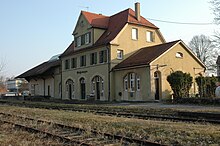



traffic
Rail and bus transport
The Ludwigsburg – Markgröningen railway was opened in 1916 after delays caused by the war, but the planned continuation via Unterriexingen and Oberriexingen to Enzweihingen was not implemented. So the route remained regionally insignificant. Against the resistance of the city, the DB stopped passenger transport in 1975. In 2002 the freight traffic to Markgröningen was stopped. Since then, tank cars have only been used on the section to the outskirts of Ludwigsburg once every working day. Since 1991 the city and the local BUND association have been trying to reactivate the railway line. However, due to its inclusion in the proposed Ludwigsburg tram, it fell on the back burner. Since 2017, the city of Ludwigsburg has also been campaigning for an immediate reactivation and extension of the route to Kornwestheim, which will later be used in mixed operation of rail and low-floor light rail, as part of a "dual strategy" agreed by the State Ministry of Transport.
Several bus lines connect Markgröningen with the S-Bahn stations in Asperg and Ludwigsburg as well as with the regional train stop in Schwieberdingen. The WBG bus line 532 runs to Unterriexingen.
The high-speed railway line Mannheim – Stuttgart crosses the Markung and the Glemstal south of the city. At the planned intermunicipal industrial park north of the Bosch site in Schwieberdingen, a stop for a regional Metropolexpress is being sought. It is hoped that this will result in a shift in the flow of commuters from Bundesstraße 10 to rail and faster access to the rail transport hubs in Stuttgart and Vaihingen / Enz.
Bypass road and environmental zone
In November 2007, the 2nd construction phase of the Markgröninger eastern bypass was completed, which made it possible to partially improve the transport infrastructure. In the opinion of the city administration, comprehensive relief of the inner city from through traffic (especially heavy traffic) and an associated improvement in air quality can only be achieved by the planned closure of the eastern bypass from Tammer to Unterriexinger Straße (3rd construction phase). This extension of the eastern bypass is also a measure proposed by a traffic expert as part of the noise action plan.

|
In 2006, the third worst air values and the highest exhaust gas values in Baden-Württemberg were measured on Grabenstrasse in Markgröningen. For this reason, this thoroughfare section was exceptionally limited to 30 km / h. From July 1, 2011, the city introduced an environmental zone . It is now limited to vehicles with a green sticker . |
Supply and disposal
Electricity and gas supply
Electric light has been around since 1906. The electricity was supplied by Elektrizitätswerk Glemsmühle GmbH . In 1915 it was connected to the regional power grid. Today the urban network is operated by EnBW Regional AG. The 380/220/110 kV substation Pulverdingen , which is operated by the transmission network operator TransnetBW , is also located in the district of Markgröningen .
So far there is only a natural gas supply in the city center. The gas network is operated by Stadtwerke Ludwigsburg-Kornwestheim GmbH. EnBW Regional AG is currently building a natural gas supply in the Unterriexingen district .
Drinking water supply
Until 1900, when the city began to lay pipes in the houses, the population had to fetch water from the numerous public wells. The population growth after the Second World War and the increasing individual water consumption made it necessary to purchase water from Lake Constance , which is mixed with its own water for the core city. The water pressure is provided by a water tower built in 1990 in the north of the city , the cantilevered elevated tank of which has a capacity of 1000 cubic meters.
The Unterriexingen district receives its drinking water from the Besigheim water supply group, which operates a waterworks in Unterriexingen. The Hardt- und Schönbühlhof gets its water from the Strohgäu water supply.
Sewage and waste disposal
The sewage system has only existed since 1928. The northern part of the core city drains into the sewage treatment plant in Leudelsbachtal that the administration union group WWTP Leudelsbach is operated. The wastewater treatment for the southern part of the city center as well as for the districts Unterriexingen and Hardt- and Schönbühlhof is carried out by the sewage treatment plant in Glemstal, which is operated by the Talhausen group sewage treatment association .
The waste is taken from the Abfallverwertungsgesellschaft the district Ludwigsburg mbH (AVL) is a wholly owned subsidiary of the district Ludwigsburg. AVL is commissioned to carry out the tasks of avoiding, recycling and disposing of waste on behalf of the Ludwigsburg district.

Health and care
In Markgröningen there is an orthopedic clinic (OKM) with a rehab center and a home for the handicapped by the LWV, integration assistance on the Hurst , several house doctors, specialists and dentists, established midwives (for home births), three pharmacies and some rehab companies and care facilities : for example the old people's and nursing homes of the district- specific Kleeblatt-Zweckverband and the ASB as well as an urban meeting place for senior citizens.
education
All types of schools are available in Markgröningen. Schools leading to the Abitur are the Hans-Grüninger-Gymnasium and the Helene-Lange-Gymnasium , which is supported as a musical and artistic advanced high school jointly by the city of Markgröningen and the district of Ludwigsburg . The range of secondary schools in Markgröningen is rounded off by the Markgröningen Realschule and the Ludwig Heyd School as a secondary school with a Werkrealschule .
Like the Landern elementary school and the Glemstal elementary school in the Unterriexingen district, the latter also serves as a primary school . There is also the August Hermann Werner School , a state school for the physically handicapped .
Hans-Grüninger-Gymnasium and Realschule were supplemented by a cafeteria in 2009. The education center on Benzberg is currently being reorganized as part of a general renovation.
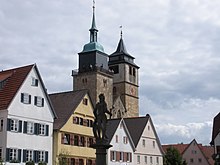
Culture and sights
Cultural offer and regular events
Numerous associations cultivating culture and traditions create a wide range of cultural activities together with the city administration. The city has a current calendar of events on its homepage.
In early summer the International Festival of Cultures takes place in the former castle courtyard.
The International Music Festival has been taking place since 1967 a week before the Schäferlauf .
Schäferlauf
Every year, on the last weekend in August, the traditional Markgröninger Heimatfest takes place: The “Historical Shepherd's Run ” goes back to the parish fair (August 24th) of the Bartholomew Church with a large fair and the annual guild day of the Württemberg shepherds, whose patron saint is Bartholomew. The “ Bartholomäus-Markt ”, also held elsewhere, was first mentioned in a document in 1445. The legend maintained in the festival even traces its origins back to the Counts of Grüningen (13th century).
The four-day program is varied: On Fridays, the performance herding starts. Saturday is the main day on which young shepherds and (unmarried) shepherd's daughters carry out their legendary barefoot race across the 300-pace-long stubble field and the shepherd's dance pays homage to the royal couple. On Sundays, the program is done with Markgröning children. On Monday, the colorful street festival in the old town and on the fairground at the castle garden will end with fireworks.
Exhibitions and guided tours
On Sundays the museum in the Wimpelinhof is open with access to the Upper Gate . Every now and then there are special exhibitions in the upper gate tower. In addition, numerous city tours on various historical topics and church tours are offered. In the anniversary year 2014 in particular to the rebellion of the poor Konrad and to the dean Reinhard Gaisser , who is considered to be the intellectual head of the resistance movement.
Buildings
Markgröningen is on the Deutsche Fachwerkstrasse . The city offers an impressive late medieval city ensemble with the Gothic St. Bartholomew's Church from the 13th to 15th centuries, which has valuable wall and ceiling paintings on the inside, the monumental half-timbered town hall , "the same is probably not found" and the atmospheric market square. In addition, there are parts of the medieval city fortifications with a younger gate tower (1555). A closer look reveals relics of the imperial castle, which was formerly separated from the city, and the castle integrated in its place into the wall ring, which was first converted into a workhouse and occasionally used as a teacher’s seminar. Today the building ensemble houses the Helene-Lange-Gymnasium (with a musical focus) jointly supported by the district and the city.
There are also many other historical buildings to look at: the relics of the former Heilig-Geist-Spital (13th to 16th centuries), two wine presses, the regional fruit box and the tithe barn as well as numerous proud town houses from the 15th and 16th centuries . For example the renovated Wimpelinhof , which has housed the municipal museum since 2005.
Former beneficiary of the hospital founded in the 13th century
Bartholomäus Church with a watch tower and bell tower
Staufer stele in front of the Bartholomäuskirche
A Staufer stele has stood in front of the main entrance of the Bartholomäuskirche, the new building of which was initiated by the anti- Staufer Count Hartmann II von Grüningen and intended as the burial place of his dynasty . This is intended to commemorate the elevation to the Free Imperial City in the time of Frederick II and at this location reflects the conflict of interest that smoldered in many imperial cities between imperial citizens and the respective lords of the castle. The stele was inaugurated by the former Prime Minister Günther Oettinger .
Sports
The umbrella organization for sports clubs in Markgröningen is the City Sports Association.
Its members include:
- the AC Italia Markgröningen (football club)
- the Christian Association of Young People (CVJM) Markgröningen,
- the football club Markgröningen (FVM), which also has a tennis department,
- the Markgröningen-Möglingen riding and driving club,
- the Markgröningen ski guild, which also has a BMX department,
- the shooting club Unterriexingen,
- the Markgröningen shooting club,
- the Turnverein Markgröningen (TVM), whose departments offer numerous sports: badminton, basketball, fistball, recreational sports, gymnastics, handball, cardiac sports, judo / aikido, children's sports, running, athletics, swimming and synchronized swimming, senior sports, dancing, tennis, table tennis, triathlon , Gymnastics and volleyball,
- the gymnastics and sports club Unterriexingen (TSV) with the following sports: football, gymnastics / fitness, children's sports, running / skiing / cycling, senior sports, dancing and gymnastics.
To mark its centenary, the Markgröningen gymnastics club, the city's oldest and largest sports club, published a 215-page chronicle in 1996.
The sports facilities at the school center on Benzberg are being expanded. A BMX area and the youth center are located between the two large sports halls and the newly created sports fields.
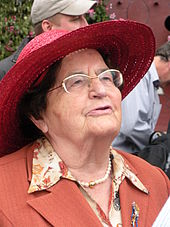



Personalities
Further historical personalities can be found under City History of Grüningen
sons and daughters of the town
- Heinrich Volland senior († 1467), temporarily Vogt and Keller in Markgröningen, merchant, 1448 richest citizen of Württemberg and probably responsible for the construction of the stately department and town hall ; Father of Aberlin II, Heinrich junior and Erhard Volland.
- Johannes Reinhard alias Hans Grüninger (1455–1533), printer and publisher a. a. in Strasbourg, from which the first geographical description of Grüningen comes and which made the Eulenspiegel legend a world best-seller.
- Ambrosius Volland (1468–1551), first clergyman and professor of both rights, then councilor and chancellor Duke Ulrichs ; after changing sides in exile (1522), he was carer of the Württemberg Prince Christoph, who was under imperial supervision, and was ennobled as councilor to Emperor Charles V.
- Philipp Volland (1474–1537), lawyer and businessman, was bailiff in Markgröningen before (1501–1519) and after his exile (1534–1537), from 1514 to 1519 a member of the regional government in Stuttgart; Adversary of poor Konrad (1514); Patron of the Heilig-Geist-Spital .
- Gottlob Christoph Paulus (1727–1790), controversial Protestant theologian, who was removed from his position as a deacon in Leonberg in 1771 and returned to Markgröningen as a privateer.
- Rudolf Friedrich Heinrich Magenau (1767–1846), clergyman, writer and local researcher.
- Hermann Reuchlin (1810–1873), internationally active historian and finally pastor of Pfrondorf .
- Wilhelm Heyd (1823–1906), deacon in Weinsberg , librarian and historian, head of the Stuttgart State Library, son of Ludwig Heyd.
- Gustav Gaupp (1844–1918), painter and lithographer, studied in Stuttgart, Vienna and London, worked in Munich, traveled to Italy and died in Obertürkheim .
- Johannes Jehle (1881–1935), organ builder and composer
- Albert Walker (1878–1963), mayor of Ebingen
- Julius Schäffer (1882–1944), teacher and mycologist ; In 1891 he was the best elementary school student and was allowed to switch to Latin school and studied theology; he died of mushroom poisoning in Weilheim in Upper Bavaria .
- Ernst Schüz (1901–1991), ornithologist
- Annemarie Griesinger (1924–2012), politician ( CDU ), Member of the Bundestag , Member of the Bundestag and Minister of the State of Baden-Württemberg ; Daughter of Hermann Roemer .
- Bernhard Walter (1942–2015), Board Member of Dresdner Bank and Supervisory Board of several large companies; Co-initiator of a foundation to finance the reconstruction of the Dresden Frauenkirche .
- Raimund Rilling (1944–2018), musician and manager.
- Uli Gutscher (* 1955), jazz musician.
Personalities associated with Markgröningen
- Count Werner IV. Von Grüningen (approx. 1060–1121), Reichssturmfähnrich, Count von Maden, Count in Neckargau and Burgrave of Worms, related to Counts of Württemberg and without a successor.
- Count Hartmann II von Grüningen (approx. 1225–1275), "Comes illustrissimus", initiated the decline of the Hohenstaufen by changing sides to the Gegenkönig in 1246; In 1252 received the castle, town and imperial storm flag from the papal rival king as own property and initiated the new construction of the Bartholomäuskirche .
- Count Hartmann III. von Grüningen (* around 1247 or 1253; † 1280), son of Hartmann II. and like that bell donor of the Bartholomäuskirche, defended the castle and town of Grüningen against the revenge policy of King Rudolf von Habsburg until his capture in 1280 and died in the dungeon on the Hohenasperg .
- Aberlin Jörg (approx. 1420–1492), the most important Württemberg builder of his time, married the Vogt's daughter Adelheid von Magstatt, who lived in Grüningen, was a taxable citizen of Grüningen in 1448 and 1471 and built the large choir and the sacristy of the Bartholomäus Church (until 1472).
- Count Eberhard im Bart (1445–1496), as long as he was underage, his guardianship council resided in Grüningen; he promoted the city as a residence in the north of the Urach part of the country and included the imperial storm flag in his ducal coat of arms.
- Reinhard Gaißer (* around 1474; † after 1533), also called "Gaißlin", theologian and professor at the University of Tübingen, who moved to St. Bartholomew's Church as pastor in 1513 and was the "first social revolutionary on a Württemberg pulpit" in the wake of poor Konrad to the uprising against the early capitalist acting honesty and the Vogt Philipp Volland called.
- Duke Christoph von Württemberg (1515–1568) had the Grüninger Reichsburg largely razed and built a Renaissance castle and the upper gate tower instead.
- Jakob Magirus (1562 / 1564–1624), hymn poet, abbot in Lorch, was special superintendent of Markgröningen from 1595 to 1602
- Duke Eberhard Ludwig von Württemberg (1676–1733), was at the court of the Sun King ( Ludwig XIV. ) Before 1700 and planned a Versailles in Württemberg with his mistress Wilhelmine von Graevenitz , which he realized in Ludwigsburg from 1704; took away Grüningen's functions as residence and official city , as high court and dean's office and divided the Schäferlauf into four parts.
- King Friedrich von Württemberg (1754–1816), led the Grüninger Graf title even in the 19th century as a secondary title, integrated the imperial storm flag into the king's coat of arms and, in the course of an administrative reform, still canceled Markgröningen's function as a city of the state .
- Heinrich Eberhard Gottlob Paulus (1761-1851), Protestant theologian and philosopher, spent his youth in Markgröningen.
- Ludwig Friedrich Heyd (1792–1842), Markgröningen parish priest and historian, published works on regional and city history (see literature list) and was made an honorary citizen.
- Christian Zeller (1822–1899), theologian and mathematician, was rector at the Markgröningen seminar.
- Gustav Jäger (1832–1917), zoologist and physician, lived in Markgröningen as a teenager.
- Paul Hug (1857–1934), politician ( SPD ), attended Latin school in Markgröningen.
- Hermann Römer (1880–1958), pastor in Bietigheim from 1912 to 1918 , from 1918 professor at the Markgröningen teachers' seminar, historian and author of the two-volume city history “Markgröningen in the context of regional history”; Father of Annemarie Griesinger and honorary citizen of Markgröningen.
- Fritz Vogelgsang (1930–2009), translator, essayist and editor, lived in Markgröningen.
- Claire Beyer (* 1947), writer, lives in Markgröningen.
- Martin von Arndt (* 1968), writer and scientist, lives in Markgröningen.
- Ulrich Steinbach (* 1968), politician ( Bündnis 90 / Die Grünen ), Member of the State Parliament in Rhineland-Palatinate, attended the Hans-Grüninger-Gymnasium here .
- Philipp Poisel (* 1983), singer-songwriter, grew up in Markgröningen
- Dominic Pencz (* 1993), photographer, grew up in Markgröningen
Additional information
literature
- 100 years of the Markgröningen voluntary fire brigade 1861/1961 . Edited by Karl Probst, 68 p., Markgröningen 1961
- 100 years of the Markgröningen gymnastics club. TVM Chronicle from 1896 to 1996. Ed. Turnverein Markgröningen 1896 e. V., 215 S., Markgröningen 1996
- 700 years of the Heilig-Geist-Spital Markgröningen . Editor: Stadt Markgröningen, 192 p., Markgröningen o. J. [1997]
- 1200 years of Markgröningen. Festival book for the 1200th anniversary of the first written mention of the name . Ed .: Stadt Markgröningen, 130 p., Markgröningen 1979
- Rudolf Dürr: Historic building sin on Spitalplatz. Old town charter for the “Unteres Tor” investor project canceled. In: Through the city glasses - historical research, stories and preservation of monuments in Markgröningen , Volume 10, ed. v. AGD Markgröningen, pp. 152–165, Markgröningen 2016
- Hilde Fendrich: From the time the Hardt-Schönbühlhof was founded. In: Through the city glasses. Volume 1, ed. v. Hilde Fendrich, pp. 11-29, Markgröningen 1985
- Peter Fendrich: The city and its citizens in the late Middle Ages. On the social structure of the Württemberg district town of Markgröningen in the context of state history. In: Volume 3 of the series Durch die Stadtbrille , ed. v. Hilde Fendrich, pp. 94-119, Markgröningen 1987
- Peter Fendrich, Günter Frank, Erich Viehöfer: Well-known and new about the Markgröningen Castle. In: Volume 8 of the series Durch die Stadtbrille , ed. v. Working Group on Historical Research and the Preservation of Monuments, Markgröningen, pp. 173–208, Markgröningen 2004
- Peter Fendrich, David Zechmeister: One hundred years of Gröninger Zügle - review of the reactivation of the Ludwigsburg – Markgröningen railway line. In: Through the city glasses - historical research, stories and monument preservation in Markgröningen. Volume 10, ed. v. AGD Markgröningen, pp. 6–25, Markgröningen 2016, ISBN 978-3000539077
- Peter Findeisen : City of Markgröningen: District of Ludwigsburg. Town center atlas Baden-Württemberg 1.7. Stuttgart: Landesdenkmalamt BW u. Land survey office BW, 1987
- Karl Erwin Fuchs: Landmarks of the city of Markgröningen. Along the border with the stock book. 102 p., Markgröningen 1987
- Helmut Hermann, Günter Frank: Markgröningen: Portrait of a city. 132 p., Markgröningen 1992
- Ludwig Friedrich Heyd : The Wirtemberg Canzler Ambrosius Volland . Stuttgart 1828 ( digitized version )
- Ludwig Heyd: History of the former Oberamts-Stadt Markgröningen with special consideration for the general history of Württemberg, mostly based on unpublished sources. Stuttgart 1829, 268 p., Facsimile edition for the Heyd anniversary, Markgröningen 1992
- Ludwig Heyd: History of the Counts of Gröningen. 106 pp., Stuttgart 1829
- Christian Hofmann: Our blood comes upon you and your children. The State Welfare Institution of Markgröningen and the Nazi murders. In: Through the city glasses - historical research, stories and monument preservation in Markgröningen. Volume 10, ed. v. AGD Markgröningen, pp. 26–39, Markgröningen 2016
- Gerhard Liebler: Markgröningen - Poetic forays through the city and its history. 88 S, Markgröningen 2001
- Gerhard Liebler: Markgröningen - entertaining encounters with the city and its history. Edited by Working Group on Historical Research and Preservation of Monuments in Markgröningen, 107 S. Markgröningen 2011
- Wolfgang Milde, Cosima Hofacker, Manfred Frank: Barefoot over the stubble field. Schäferlauf Markgröningen: amusing, original, right in the middle. Ed .: Stadt Markgröningen, 112 p., Markgröningen 2008
- Eduard Paulus : The art and antiquity monuments in the Kingdom of Württemberg, Bd. 1: Neckarkreis. Stuttgart [u. a.] 1889
- Karl Eduard Paulus u. a .: Markgröningen. In: Description of the Oberamt Ludwigsburg. Ed .: Königlich Statistisch-Topographisches Bureau, Stuttgart 1859, pp. 247–275. Reprint: Bissinger, Magstadt, ISBN 3-7644-0038-2 , Wikisource
- Philipp Ludwig Hermann Röder : The city and the office of Gröningen. In: Geography and Statistics Wirtembergs , pp. 358–361. Laybach in Krain 1787 digitized
- Philipp LH Röder: Gröningen. In: Geographical statistical-topographical lexicon of Swabia , Volume 1, pp. 619–625. Ulm 1791 digitized
- Hermann Römer : Markgröningen in the context of regional history I. Prehistory and the Middle Ages. 291 p., Markgröningen 1933
- Hermann Römer: Markgröningen in the context of regional history 1550–1750. In: Ludwigsburger Geschichtsblätter , Heft 11 (1930), pp. 1–133.
- Petra Schad: Markgröningen - a city guide. 80 p., Markgröningen 2003
- Petra Schad: The dissolution of the traditional Markgröningen office. In: Ludwigsburger Geschichtsblätter , No. 58, pp. 135–157, Ludwigsburg 2004
- Petra Schad: From the community center to the community center. The Wimpelinhof then and now. Ed .: Stadt Markgröningen, 72 p., Markgröningen 2005
- Anneliese Seeliger-Zeiss: Historical inscriptions in Markgröningen - a selection. In: Through the city glasses. Volume 4, ed. v. Hilde Fendrich, pp. 37-53, Markgröningen 1986
- Elsbeth Sieb: Markgröningen in old pictures. 96 p., Horb 1988
- Elsbeth Sieb: Markgröningen is blowing its walls. In: Through the city glasses. Volume 6, ed. v. Working group for historical research, heritage and monument preservation Markgröningen, pp. 118–135, Markgröningen 2000
- Erich Tomschik u. a .: Markgröningen. The image of the city through the ages. Ed .: Stadt Markgröningen, 112 p., Markgröningen 1969
- Erich Tomschik u. a .: The Markgröninger Schäferlauf. Ed .: Working group for historical research, heritage and heritage preservation Markgröningen, 192 p., Markgröningen 1971
Through the city glasses (city history series)
- Through the city glasses. History and stories about Markgröningen . Volumes 1–4 without a focus. Ed .: Hilde Fendrich. Volksbank Markgröningen eG, Markgröningen 1985–1989
- Millers, mills, hydropower . Volume 5 of the series Through the City Glasses , ed. v. Working group for historical research, heritage and monument preservation Markgröningen, 181 p., Markgröningen 1995
- Markgröningen - people and their city. Comprehensive presentation of the city's recent history in approx. 60 individual articles. Volume 6 of the series Through the City Glasses , ed. v. Working Group on Historical Research, Heritage and Monument Preservation Markgröningen, 477 p., Markgröningen 2000
- Markgröningen buildings and their history, part 1: From the Bartholomäus church to the hospital church. Volume 7 of the series Through the City Glasses , ed. v. Working Group on Historical Research and Monument Preservation Markgröningen, 132 p., Markgröningen 2002
- Markgröningen buildings and their history, part 2: Urban, stately and town houses in the Upper City . Volume 8 of the series Through the City Glasses , ed. v. AGD Markgröningen, 264 p., Markgröningen 2004
- Markgröningen and its Schäferlauf. Everything about the Schäferlauf in 3 parts: Origin and development of the Schäferfest - post-war hardship, hunger for life and the return of the Schäferlauf 1947 - Schäferlauf alphabet . By Petra Schad u. Gerhard Liebler, Volume 9 of the series Durch die Stadtbrille , ed. v. AGD Markgröningen, 121 S., Markgröningen 2007
- Through the city glasses - historical research, stories and preservation of monuments in Markgröningen , Volume 10, ed. v. AGD Markgröningen, 168 p., Markgröningen 2016, ISBN 978-3-00-053907-7
Web links
- Official website of the city
- Working group for historical research and monument preservation in Markgröningen
- Internet pages of the departments of the Markgröningen gymnastics club
Remarks
- ↑ In the High Middle Ages the spellings Grieningen , Grüningen , Grünigen and later also Gröningen appear . Grüningen prevailed in official documents ; from the 17th century on there is more and more Gröningen . Markgröningen only became official in the 18th century. However, neither with King Friedrich, who in 1806 still had the sub-title Graf zu Gröningen , nor with the city's magistrate, who of course wrote Gröningen in a petition to the new King Wilhelm on November 20, 1816 .
- ↑ More detailed argumentation for the derivation of the prefix Mark under Stadtgeschichte von Grüningen # From Gruoninga via Grüningen to Mark (t) gröningen .
- ↑ See town history of Grüningen # Modernization at the expense of the cultural heritage .
- ↑ You can get the tower key from the museum supervisor.
Individual evidence
- ↑ State Statistical Office Baden-Württemberg - Population by nationality and gender on December 31, 2018 (CSV file) ( help on this ).
- ↑ Published 1643, see Topographia Sueviae and Wikisource
- ↑ WUB Volume II., No. NA, pp. 437-438, online
- ↑ The prefix is not a Grüninger invention and is still used reluctantly by long-time residents. According to Philipp Ludwig Hermann Röder , in Geographisches Statistisches-Topographisches Lexikon von Schwaben , Volume 1, Ulm 1791, p. 619, initially only the “rabble” named the city “Markgröningen”; in the lexicon he led them under "Gröningen". Digital version of the BSB (PDF)
- ↑ Source: Fries, L., 1527, passage inserted by the publisher and printer Hans Grüninger; as a facsimile from Hermann Römer: Markgröningen in the context of regional history I. Prehistory and the Middle Ages. 291 S., Markgröningen 1933, p. 285
- ↑ See "Grüningen" or "Marckt Gröningen" in the Topographia Germaniae published in 1643 - digitized at Wikisource .
- ↑ In line with this approach, the city painter Christian von Martens , who traveled through in 1819 and labeled his water-colored drawing of the city with “Markt-Gröningen”, obviously derived the prefix from Markt and therefore misspelled the name. See Landesarchiv BW online
- ↑ State Statistical Office, area since 1988 according to actual use for Markgröningen.
- ↑ See map of the Federal Agency for Nature Conservation (BfN) and LUBW overview map of the Natura 2000 management plan ( memento of October 24, 2014 in the Internet Archive ).
- ↑ The painter of this reproduction is not verified; the original probably came from Carl Urban Keller , who also drew the city gates.
- ↑ See Peter Fendrich: The city and its citizens in the late Middle Ages. On the social structure of the Württemberg district town of Markgröningen in the context of state history. In: Volume 3 of the series Durch die Stadtbrille , ed. v. Hilde Fendrich, pp. 94-119, Markgröningen 1987, pp. 94 ff.
- ↑ See Hermann Römer: Markgröningen in the context of regional history I. Prehistory and the Middle Ages. 291 S., Markgröningen 1933, pp. 190 ff., Who made the Vollands jointly responsible for early capitalist grievances and described Gaisser's revolutionary activities in detail.
- ↑ Plus relatives 352 residents; see 1200 years of Markgröningen. Festival book for the 1200th anniversary of the first written mention of the name . Ed .: Stadt Markgröningen, 130 p., Markgröningen 1979, p. 104
- ↑ See Ludwig Heyd: History of the former Oberamts-Stadt Markgröningen with special regard to the general history of Württemberg, mostly based on unpublished sources. Stuttgart 1829, p. 93 ff.
- ↑ See Anneliese Seeliger-Zeiss: Historical inscriptions in Markgröningen - a selection. In: Through the city glasses. Volume 4, ed. v. Hilde Fendrich, pp. 37-53, Markgröningen 1986, pp. 47-64
- ↑ See Ludwig Heyd: History of the former Oberamts-Stadt Markgröningen with special regard to the general history of Württemberg, mostly based on unpublished sources. Stuttgart 1829, pp. 112-120
- ↑ In 1634 there were 1645 inhabitants, in 1735 there were again 1640; see 1200 years of Markgröningen. Festival book for the 1200th anniversary of the first written mention of the name . Ed .: Stadt Markgröningen, 130 p., Markgröningen 1979, p. 104
- ↑ Landesarchiv BW A 349L to Geistl. Administration of Markgröningen
- ↑ See Gerhard Liebler: Markgröningen - Entertaining encounters with the city and its history. Edited by Working Group on Historical Research and Preservation of Monuments Markgröningen, 107 p. Markgröningen 2011, p. 90 ff.
- ↑ As a contemporary affected by the consequences, Ludwig Heyd describes: History of the former Oberamts-Stadt Markgröningen with special consideration for the general history of Württemberg, mostly based on unpublished sources. Stuttgart 1829, p. 120 ff., The mood of the Markgröninger is very impressive.
- ↑ It is noteworthy that the magistrate still officially called the city Gröningen in 1816 .
- ↑ The text of the petition can be found in Gerhard Liebler: Markgröningen - Kurzweilige Treffen mit der Stadt und its history. Edited by Working Group on Historical Research and Monument Preservation Markgröningen, 107 p. Markgröningen 2011, p. 97 f.
- ↑ Source: Landesarchiv Baden-Württemberg, inventory F 26 Kameralamt
- ↑ In the thirties it had around 300 inmates. See Elsbeth Sieb: Markgröningen in old pictures. 96 S., Horb 1988, p. 67
- ↑ See 1200 years of Markgröningen. Festival book for the 1200th anniversary of the first written mention of the name . Ed .: Stadt Markgröningen, 130 p., Markgröningen 1979, p. 104
- ↑ See Liebler, 2000, in Markgröningen - people and their city. Comprehensive presentation of the city's recent history in approx. 60 individual articles. Volume 6 of the series Through the City Glasses , ed. v. Working group for historical research, heritage and monument preservation Markgröningen, 477 p., Markgröningen 2000, pp. 198–221
- ↑ Hilde Fendrich: The Friends of Nature House in Markgröningen. In: Markgröningen - people and their city , Through the city glasses , Volume 6, Markgröningen 2000, pp. 114–117.hrsg. from AGD Markgröningen
- ↑ Memorial sites for the victims of National Socialism. A documentation, Volume I, Bonn 1995, pp. 60f., ISBN 3-89331-208-0
- ^ Markgröningen - people and their city. , Volume 6 of the series "Durch die Stadtbrille", ed. v. Working group for historical research and monument preservation Markgröningen, Markgröningen 2000, p. 328ff.
- ↑ See contemporary witness reports in Markgröningen - people and their city. Comprehensive presentation of the city's recent history in approx. 60 individual articles. Volume 6 of the series Through the City Glasses , ed. v. Working group for historical research, heritage and monument preservation Markgröningen, 477 p., Markgröningen 2000, p. 342 ff.
- ↑ A daughter of the Müller family survived because she was on a spare time. An employee had hidden in time. See H. Fendrich, In Markgröningen - people and their city. Comprehensive presentation of the city's recent history in approx. 60 individual articles. Volume 6 of the series Through the City Glasses , ed. v. Working group for historical research, heritage and monument preservation Markgröningen, 477 p., Markgröningen 2000, p. 355 ff.
- ↑ See 1200 years of Markgröningen. Festival book for the 1200th anniversary of the first written mention of the name . Ed .: Stadt Markgröningen, 130 p., Markgröningen 1979, p. 98
- ↑ See pictures of lost buildings .
- ↑ See festival book 1200 years of Markgröningen. Festival book for the 1200th anniversary of the first written mention of the name . Ed .: Stadt Markgröningen, 130 p., Markgröningen 1979
- ^ Federal Statistical Office (ed.): Historical municipality directory for the Federal Republic of Germany. Name, border and key number changes in municipalities, counties and administrative districts from May 27, 1970 to December 31, 1982 . W. Kohlhammer, Stuttgart / Mainz 1983, ISBN 3-17-003263-1 , p. 453 .
- ↑ Quote from Hans Grüninger , see Hermann Römer: Markgröningen in the context of regional history I. Prehistory and the Middle Ages. 291 S., Markgröningen 1933, p. 285
- ^ Election information for the municipal data center
- ↑ Michaela Glemser: Markgröningen: Fake sub-town selection remains - 41.89 percent want the previous system
- ↑ Working group on historical research and the preservation of monuments in Markgröningen: flag and coat of arms
- ↑ Andreas Megerle u. Jürgen Resch: The Crau - stone steppe full of life (nature guide), 116 S., Radolfzell 1987.
- ↑ Natural vacation around St.-Martin-de-Crau. Travel guide to the environmentally oriented city partnership . Ed .: Stadt Markgröningen (2nd edition), 20 pages, Markgröningen 2003.
- ↑ Main and part-time agricultural businesses - Markgröningen, Stadt ( Memento from December 3, 2013 in the web archive archive.today )
- ↑ More on this in Müller, Mühlen, Wasserkraft . Volume 5 of the series Through the City Glasses , ed. v. Working group for historical research, heritage and monument preservation Markgröningen, 181 p., Markgröningen 1995
- ↑ See TLT relies on the Markgröningen plant , in: Ludwigsburger Kreiszeitung , 23 May 2014.
- ↑ See municipal council resolution on the city of Ludwigsburg's regional rail transport concept
- ↑ See SPNV concepts at AGD Markgröningen
- ↑ That will change for drivers in 2011 , accessed on T-Online on November 18, 2010
- ↑ Environmental zone Change of traffic regulations within the scope of the clean air plan for the Stuttgart administrative region - Markgröningen sub-plan. Retrieved April 30, 2019 .
- ↑ BDEW (Ed.): Map of the electricity network operator 2012. Frankfurt 2012.
- ↑ BDEW (Ed.): Map of the gas network operators 2012. Frankfurt 2012.
- ↑ Südwest Presse: Connection to the regional natural gas network for Markgröningen's Unterriexingen district. Edition February 20, 2013.
- ↑ Municipal waterworks Markgröningen: Water - the basis of all life. Markgröningen 2008.
- ↑ Articles of Association of the Leudelsbach Group Sewage Works Association. Retrieved April 30, 2019 . (PDF)
- ↑ Purpose association group sewage treatment plant Talhausen: Statutes of the waste water treatment group group sewage treatment plant Talhausen. Markgröningen 2005. Source: Articles of Association as PDF . See website of the association
- ↑ Information on the city tour and guided tours: City tour. Retrieved April 30, 2019 . and city tours. Retrieved April 30, 2019 .
- ^ Quote from Hans Grüninger in Fries, L., 1527, passage from the publisher and printer Hans Grüninger inserted; as a facsimile from Hermann Römer: Markgröningen in the context of regional history I. Prehistory and the Middle Ages. 291 p., Markgröningen 1933
- ↑ See Petra Schad: From the community center to the home of the community. The Wimpelinhof then and now. Ed .: Stadt Markgröningen, 72 p., Markgröningen 2005
- ↑ Markgröningen 2012 on stauferstelen.net. Retrieved March 23, 2014.
- ↑ See 100 years of the Markgröningen gymnastics club. TVM Chronicle from 1896 to 1996. Ed. Turnverein Markgröningen 1896 e. V., 215 S., Markgröningen 1996
- ↑ He pushed Lorenz Fries 1527 a short portrait about "Margt Grien Ingen" below. Facsimile from Hermann Römer: Markgröningen in the context of regional history I. Prehistory and the Middle Ages. 291 S., Markgröningen 1933, p. 285
- ↑ See 450 Years of the Reformation in Esslingen (exhibition catalog), ed. v. Esslingen City Archives, Sigmaringen 1981, p. 119 f. and p. 143
- ↑ See Hermann Römer: Markgröningen in the context of regional history I. Prehistory and the Middle Ages. 291 p., Markgröningen 1933, p. 190 ff.
- ↑ Quotation: "We, Friderich by God's grace, King of Württemberg, sovereign Duke in Swabia and von Teck, Duke of Hohenlohe, Landgrave of Tübingen and Nellenburg, Prince of Ellwangen, ..., Count of Gröningen ... make it known ..." State bibliography of Baden-Württemberg (BSZ)





